In an era where technology ceaselessly redefines the contours of our society, the rise of Artificial Intelligence (AI) stands as one of the most significant digital transformations.
With the potential to add a staggering $9 trillion to the global GDP by 2030, AI is not just reshaping industries – it’s rewriting the rules of the game.
From the dynamic world of conversational AI technologies, including innovations like ChatGPT, to the realm of self-driving vehicles, AI has become a central player. It’s driving some of the most exhilarating yet contentious tech advancements we’ve seen in the 21st century.
However, questions often arise about the true scale of the AI industry and the rapidity of its expansion. How extensive is the impact of AI, and at what speed is it transforming our world?
In this comprehensive piece, we will not only delve deeper into the critical statistics surrounding AI but also explore its anticipated growth trajectories. We aim to provide a clear picture of how AI is poised to shape the future of technology and society at large.
Contents
Top AI Statistics
Economy, Jobs & AI Statistics
AI Usage Statistics
AI Risk Statistics
AI impact on IT
AI Statistics By Industry
Healthcare
Publishing
Insurance
Retail
Manufacturing
AI Adoption Statistics
Chat GPT Statistics
What Is The Future Of Artificial Intelligence?
Sources
Top AI Statistics
These data points showcase the widespread adoption of AI across various sectors, the economy, and the labor market.
Understanding these statistics will help you gain a comprehensive understanding of the rapid advancement of AI and its potential to shape our future.
- According to MarketsAndMarkets, the AI market is forecasted to reach an astounding $407 billion by 2027, reflecting significant growth from its projected revenue of $86.9 billion in 2022. Looking at the global level, this growth is attributed to factors such as rising AI investments, increasing demand for automated customer support solutions, and the rapid adoption of technologies across various industries.
- The latest data from Statista suggests that by 2030, it is projected that AI will make a substantial 21% net addition to the United States GDP, underscoring its profound influence on economic growth. This suggests strong growth potential in the near future and a huge opportunity for businesses to tap into this trend. We also expect the AI market in the United States to see a significant expansion, growing by 15.36% from 2023 to 2030, culminating in a market volume of approximately $237 billion in 2030.
- According to Forbes, AI is projected to contribute a significant 21% net boost to the GDP of the United States by 2030, highlighting its profound impact on economic growth. And because GDP is directly linked to the job market, we’re expected to see an AI-induced surge in jobs as well. This should encourage businesses to focus on leveraging AI’s potential and gain a strategic advantage in the competitive marketplace.
- According to ChaptGPTs’ data, they had 1 million users within the first five days of being available. This is by far the fastest adoption rate of any AI technology to date, highlighting the massive potential of AI and its ability to rapidly revolutionize businesses. Not only have generative AI-enabled companies produced high-quality content faster and more efficiently, but it has also created new opportunities for monetizing content in ways that were not possible before. But that’s not all. Chat GPT is having a major effect on the insurance industry and bringing about operational efficiencies that were not possible before.
- In the same study conducted by Forbes Advisor, a whopping 64% of businesses are optimistic that artificial intelligence (AI) will boost their productivity. This finding underscores the increasing confidence in the transformative power of AI on business operations. Business leaders are starting to understand that AI offers tremendous potential for streamlining processes, reducing costs, and maximizing efficiency.
Annual global revenue of the AI software market from 2018 to 2025
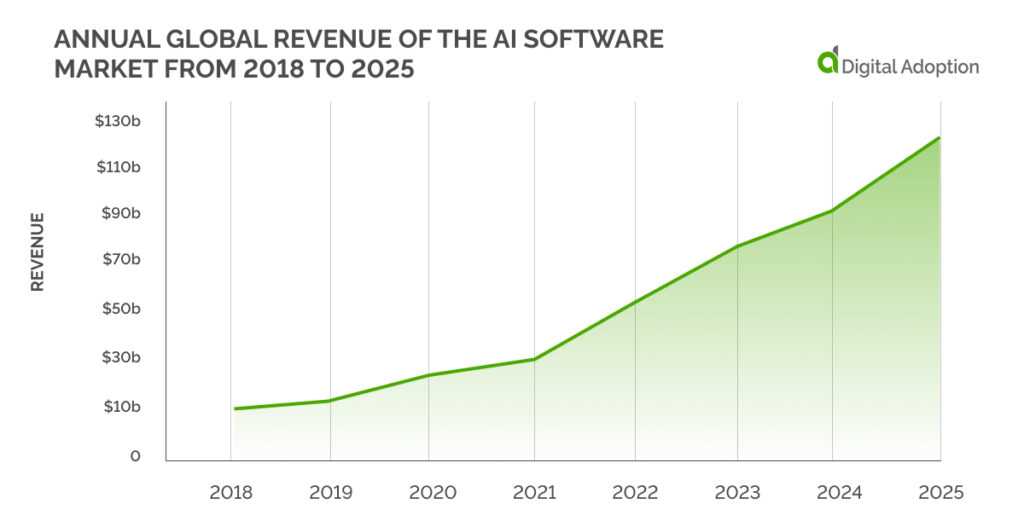
| Year | Revenue |
| 2018 | $10.1 billion |
| 2019* | $14.69 billion |
| 2020* | $22.59 billion |
| 2021* | $34.87 billion |
| 2022* | $51.27 billion |
| 2023* | $70.94 billion |
| 2024* | $94.41 billion |
| 2025* | $126 billion |
Chart showing Year on year growth increasing by at least 26% each year until 2025
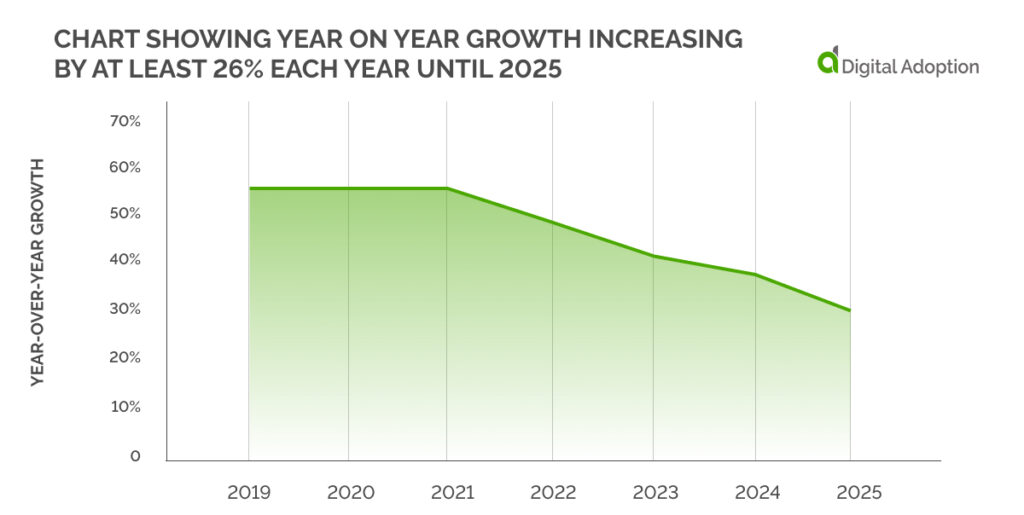
| Year | Year-Over-Year Growth |
| 2019 | 54% |
| 2020 | 54% |
| 2021 | 54% |
| 2022 | 47% |
| 2023 | 38% |
| 2024 | 33% |
| 2025 | 26% |
Economy, Jobs, and AI Statistics
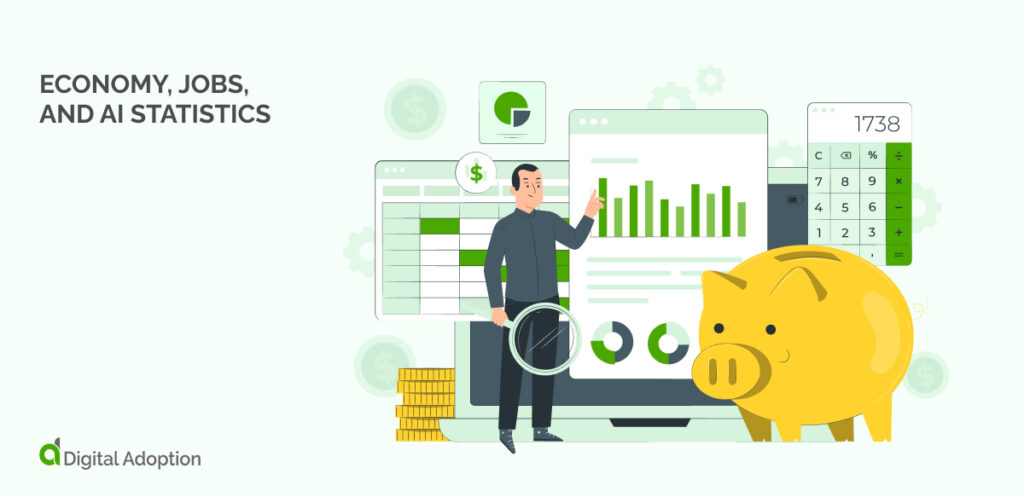
As we delve into the world of Artificial Intelligence (AI), one cannot overlook its profound impact on the economy and job landscape.
With its transformative potential, AI is not just a technological marvel but also a pivotal economic catalyst.
In this section, we will present vital statistics that illustrate the immense influence of AI on global economies and jobs, highlighting how this digital revolution is reshaping industries and redefining occupational roles across the globe.
From potential GDP growth to shifts in employment patterns, these statistics will provide a comprehensive understanding of the interplay between AI, economies, and jobs.
- $9 trillion
Additional GDP due to AI by 2030
The rise in GDP from product improvements, along with changes in consumer needs, behaviors, and spending as a result of AI, will eventually surpass productivity increases, possibly contributing over $9 trillion1 to additional GDP by 2030. China and North America are anticipated to experience the largest impact, but all economies are expected to see benefits1.
- 5.5%
Generative AI’s Impact on High-Income Countries by 2023
The ILO’s 202317 analysis indicates that while just 0.4% of jobs in low-income nations may feel the effects of automation due to Generative AI, this figure significantly jumps to 5.5% in high-income countries.
- 75%
Tech Adoption in the Next Five Years
According to the Future of Jobs Survey 2023 by the World Economic Forum18, over 75% of companies aim to adopt technologies like big data, cloud computing, and AI within the next five years. The data underscores the sweeping influence of digitalization on commerce and trade.
- 23%
Employers Anticipate Job Market Churn in the Next 5 Years
Employers expect a structural shift affecting 23%18 of jobs within the next five years, according to the Future of Jobs Survey 2023 by the World Economic Forum. This represents an aggregate measure of labor market disruption, consisting of both emerging jobs being added and declining jobs being phased out.
- 75%
AI Adoption & Job Market Impact
Artificial Intelligence, a pivotal factor in potential algorithmic job displacement, is expected to be embraced by nearly 75% of surveyed firms18, according to the Future of Jobs Survey 2023 by the World Economic Forum. This adoption will likely result in high job market churn. Specifically, 50% of organizations anticipate AI will spur job growth, while 25% foresee it leading to job losses.
AI Usage Statistics
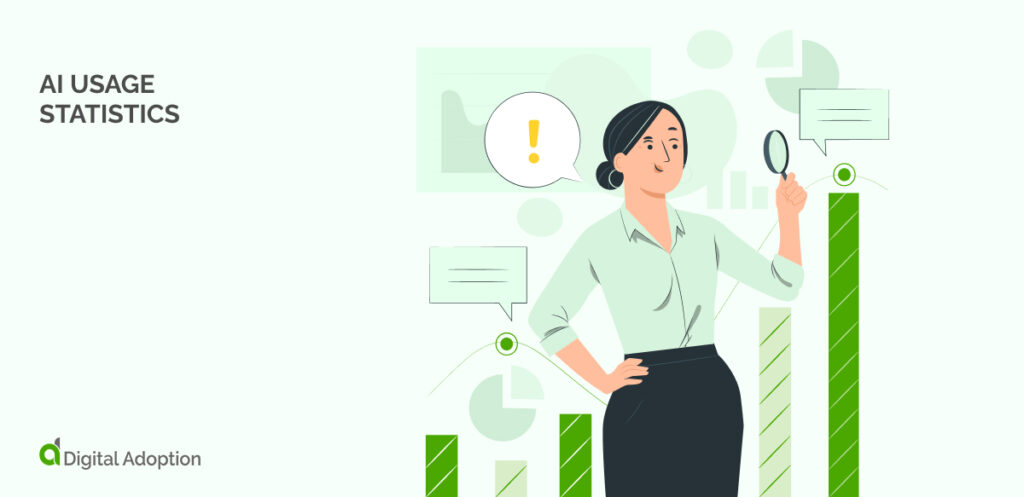
In this era of digital transformation, Artificial Intelligence (AI) has rapidly transitioned from a futuristic concept to a prevalent reality. Its pervasive presence across various sectors underlines its immense potential and integral role in our daily lives.
The following section will delve into detailed AI usage statistics, providing a comprehensive overview of how widespread and deeply embedded this technology has become.
Whether it’s businesses employing AI to improve their decision-making processes or consumers taking advantage of AI-powered tools for added convenience, these statistics will underscore AI’s comprehensive scope and deep-seated impact in today’s society.
- 10%
Share of workers who use AI at work in Europe
The highest workplace usage of AI is reported in Europe (10%)2 and Greater China (9%), while North America leads in combined work and non-work usage (22%). These figures are based on the McKinsey Global Survey on AI2 conducted in April 2023 with 1,684 participants. Asia-Pacific and developing markets show the highest rates of usage outside of work, both at 20%.
- 14%
Share of marketing and sales team firms that use AI
Among the 1,684 participants surveyed in the McKinsey Global Survey on AI2 conducted in April 2023, the Marketing and Sales department stands out as the leading adopter, with 14%2 of respondents indicating regular use of generative AI. This is closely followed by the Product/Service Development department at 13%.
- 79%
General Exposure to Generative AI Across Various Industries
According to McKinsey Global Survey data2, 79% of respondents have had some level of exposure to generative AI, either professionally or personally. Of these, 22% report regularly utilizing generative AI in their work. The technology sees its highest adoption rates among those in the tech sector and professionals based in North America.
- 33%
Widespread Use of Generative AI in Organizational Functions
One-third of survey respondents2 report that their organizations already use generative AI in at least one function. This implies that among organizations that have adopted AI, 60% are specifically employing generative AI.
- 40%
Anticipated Increase in AI Investment Due to Generative AI
Among organizations that have adopted AI2, 40% expect to increase their overall AI investment due to the influence of generative AI. Additionally, 28% indicate that generative AI is already a topic on their board’s agenda.
AI Risk Statistics
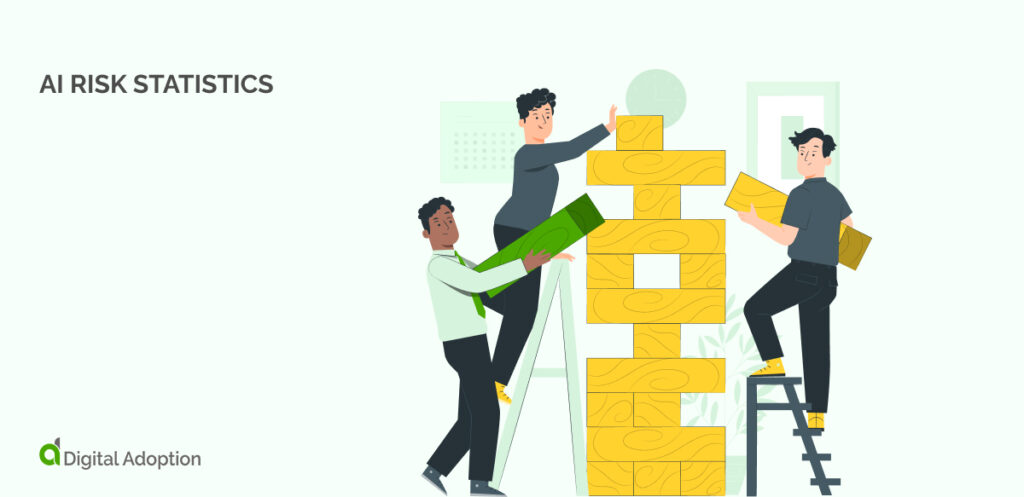
While the rise of Artificial Intelligence (AI) has undeniably brought about a host of benefits and opportunities, it’s critical to acknowledge the accompanying risks. These span from privacy concerns ethical implications, and even potential job displacement.
This section will explore the various AI risk statistics, painting a holistic and objective picture of the potential challenges that this revolutionary technology presents.
The aim is not to instill fear but to promote an informed understanding of the need for appropriate regulation and careful implementation of AI in our increasingly digital world.
- 56%
Share of organizations that consider “inaccuracy” as the most relevant AI-related risk
The results are based on a survey by McKinsey Global on AI2 in April 2023. Among the organizations that have adopted AI in at least one function, the foremost concerns revolve around the inaccuracy of AI outputs, with 56%2 of respondents considering it a risk. Cyber security concerns closely follow at 53%.
- 81%
Call for Government Regulation on AI Bias
DataRobot’s State of AI Bias Report19, which analyzed over 350 organizations across various sectors, shows that 54% of leaders are deeply concerned about the risk of bias in AI. A notable 81% express a growing desire for government intervention to prevent such biases.
- 77%
Organizations that struggle to eliminate AI Bias
Despite having AI bias or algorithm tests in place, as found in 77% of surveyed organizations, efforts to eliminate algorithmic bias are still falling short19. This comes even as there is significant focus and investment across the industry to tackle this issue. The findings indicate persistent challenges in effectively removing bias from AI systems.
AI impact on IT
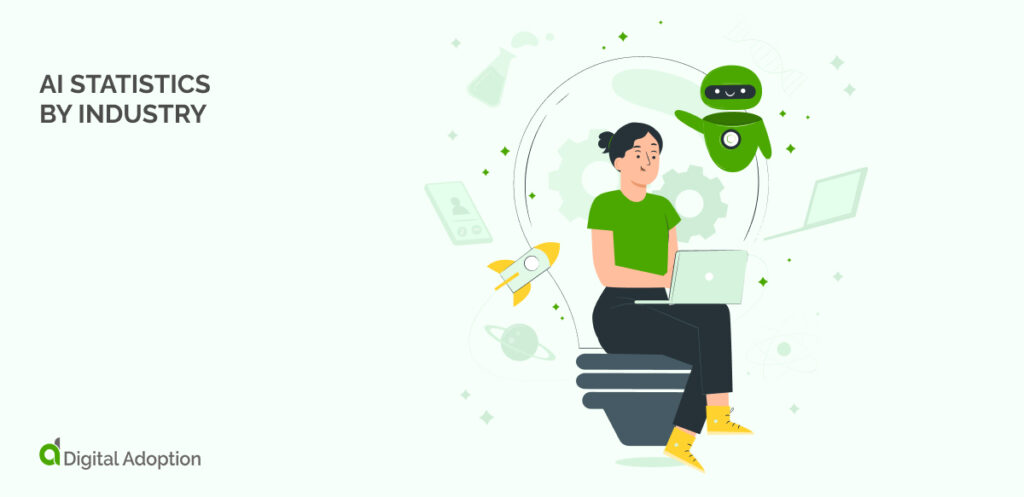
As we delve into the digital age, Artificial Intelligence (AI) is significantly reshaping various sectors, and Information Technology (IT) is no exception.
The impact of AI on IT is profound, bringing forth a paradigm shift in how IT operations are managed and executed.
From automating mundane tasks to enhancing cybersecurity measures, AI’s influence in the IT sphere transforms traditional systems and sets new benchmarks for efficiency and innovation.
This section will explore how AI influences and revolutionizes the IT industry:
14. 67%
IT leaders who consider AI as a Business Priority
Salesforce’s Generative AI Snapshot Research Series20 surveyed over 4,000 full-time workers across multiple sectors. It reveals that 67% of IT leaders have marked generative AI as a business priority for the next 18 months. Among these, 33% consider it a top priority.
15. 57%
Senior IT leaders who view generative AI as a ‘Game Changer’
The data shows that 57%20 of senior IT leaders consider generative AI a pivotal technology that can enhance customer service, data utilization, and operational efficiency. Interestingly, even among the 80% who feel the technology is ‘over-hyped,’ there’s a consensus that generative AI will improve customer service.
16. 64%
IT leaders who have Ethical Concerns About Generative AI
Despite a strong enthusiasm for the capabilities of generative AI, 64%20 of IT decision-makers express reservations about the technology’s ethical dimensions. Additionally, 62% are concerned about how the adoption of generative AI could potentially impact their careers.
17. 87%
IT leaders who anticipate Investment in automation over the next 18 months
A significant majority of IT leaders (87%)20 expect to see increased investment in automation technologies within their organizations over the next 18 months. This sentiment aligns with the fact that 58% of these leaders are currently not fully satisfied with the existing level of automation in their operations.
18. 67%
IT Leaders who Struggle to Balance Innovation with Security Risks
As technology rapidly evolves, 67%20 of IT leaders find themselves in a dilemma. While these advancements enable the creation of innovative applications, they also introduce new security vulnerabilities that could be exploited. This has led to difficulties in striking a balance between achieving business objectives and maintaining security.
AI Statistics By Industry
As we delve deeper into the digital age, Artificial Intelligence (AI) continues to evolve at an unprecedented pace. Its transformative potential is immense, promising to revolutionize various industries.
In the following section, we will explore AI statistics in different industries and discuss how AI can be used to maximize potential in each sector.
We will focus on healthcare, banking, publishing, and insurance, as these areas have seen significant advances in implementing AI technologies.
AI Healthcare Statistics
The healthcare industry is being radically transformed by the power of Artificial Intelligence (AI). With its unprecedented computational capabilities, AI is pushing the boundaries of innovation, offering a new horizon of possibilities in diagnostics, patient care, and administrative efficiency.
These AI statistics demonstrate the potential of AI to revolutionize healthcare:
19. 44%
Highest Trust in AI for Healthcare Diagnosis and Treatment
Based on a survey of 17,193 respondents across 17 countries 23, between September and
October 2022, 44% trust the application of AI most when it comes to healthcare diagnosis and treatment. This high level of trust is attributed to the direct benefits of improved medical accuracy and widespread trust in healthcare professionals.
20. 50%
Share of people who are willing to share information with Healthcare AI providers
Survey results 23 indicate that people are generally more willing to rely on Security and Recommender AI than share information with them. However, this trend is reversed for Healthcare AI, where respondents are more willing to share information than rely solely on the AI’s outcomes. This likely reflects the routine practice of sharing medical information with healthcare providers for effective care.
21. 40%
Americans Believe AI Will Reduce Healthcare Mistakes
According to a Pew Research survey24, a larger proportion of Americans (40%) believe that implementing AI in health and medicine will reduce the number of mistakes made by healthcare providers, as opposed to the 27% who think it will increase errors.
22. 51%
Americans Believe AI Will Improve Racial and Ethnic Bias in Healthcare
Among the majority of Americans who perceive a problem with racial and ethnic bias in healthcare, a significant 51% believe24 that the situation would improve if AI were used more extensively for tasks such as diagnosing diseases and recommending treatments. This is in stark contrast to the 15% who think the problem will worsen.
23. 50%
Higher Education Linked to Positive Outlook on AI in Healthcare
Among individuals with a postgraduate degree, 50% believe24 that using AI in tasks such as diagnosing diseases and recommending treatments will result in better health outcomes for patients. This group’s optimistic view contrasts sharply with a significantly smaller percentage (26%) who think AI would lead to worse outcomes. This trend is generally consistent among men, younger adults, and those with higher levels of education.
AI Healthcare Insights
In the realm of diagnostics, AI has emerged as a powerful ally. Its sophisticated algorithms can scrutinize medical images or genomic data with superior precision, enabling early detection of diseases like cancer. These algorithms are built on machine learning models that can not only diagnose but also predict the trajectory of a disease, empowering physicians with strategic insights for formulating effective treatment plans.
Transitioning to patient care, AI’s impact is equally profound. The advent of AI-powered chatbots and wearable devices has revolutionized patient engagement. Chatbots offer round-the-clock patient support, answering queries and providing medical advice. On the other hand, wearable devices monitor patients’ vital signs relentlessly, ensuring timely medical intervention when necessary.
AI’s influence also extends to the administrative aspects of healthcare. By leveraging predictive analytics, AI optimizes hospital operations such as appointment scheduling and patient flow management, enhancing operational efficiency and cost-effectiveness.
Furthermore, AI’s prowess in handling voluminous data is accelerating research and development in healthcare. It can unearth patterns and insights from complex medical datasets, expediting drug discovery and development processes.
AI & Healthcare In a Nutshell: AI is not just a technological marvel; it’s a catalyst for transformation in the healthcare industry. By bridging the gap between technology and healthcare, AI fosters a paradigm shift towards more effective, efficient, and personalized healthcare delivery.
AI Publishing Statistics
Artificial Intelligence (AI) is ushering in a transformative era in the publishing industry, streamlining operations and reshaping traditional workflows.
The following statistics highlight just a few of the ways that AI is revolutionizing publishing:
24. 4,96,010
Number of AI Publications in the World in 2021
Between 2010 and 2021, AI publications saw an impressive increase, surging from 2,00,000 to nearly 5,00,0003
25. 59,360
Number of AI Publications in pattern recognition in 2021, the most for any field of study
Starting from 2015, publications in pattern recognition approximately doubled3, whereas those in machine learning saw a fourfold increase. In 2021, after these two subjects, the leading AI research areas were computer vision with 30,075 papers, followed by algorithms at 21,527, and data mining with 19,181 publications.
26. 75%
AI publications in the education sector as a share of total publications in 2021
The education sector dominates sector-wise AI publication. The other sectors — non-profits, industry, and government — all feature distant seconds.3
27. 10,470
AI publications born out of the collaboration between the United States and China in 2021
Over the last 12 years, the most significant collaborations were predominantly between the United States and China, with their collaborative efforts growing approximately fourfold since 2010. Following this, the United Kingdom had its most substantial collaborations with both China and the United States.3
28. No 1
Chinese Academy of Sciences ranking among world institutions in terms of number of AI publications in all fields between 2010–21
From 2010 onward, the Chinese Academy of Sciences has been the leading institution in terms of AI paper publication3. The subsequent four institutions with the highest output are all Chinese universities: Tsinghua University, the University of the Chinese Academy of Sciences, Shanghai Jiao Tong University, and Zhejiang University.
29. 3,47,934
Number of GitHub AI Projects in 2022
A GitHub project comprises a set of files encompassing source code, documentation, configuration details, and images, which together form a software project. There has been a consistent rise in AI-related GitHub projects since 2011, soaring from 1,536 that year to a staggering 3,47,934 in 20223.
30. 24%
GitHub AI Projects from India as a % of the total in 2022
In 2022, a significant chunk of AI projects on GitHub came from software developers in India, accounting for 24.2%3. Following India, developers from the European Union and the United Kingdom contributed 17.3%, while the United States represented 14.0%.
AI Publishing Insights
In the domain of manuscript editing, AI-driven algorithms are significantly refining the process. These intelligent systems can rapidly scan through textual content, identifying and correcting errors with unprecedented accuracy. This not only enhances the quality of the final product but also accelerates the overall publishing timeline.
The realm of content creation is also witnessing AI’s disruptive influence. Advanced AI tools are capable of generating full-length e-books, marking a paradigm shift in how content is created. This not only expedites the production process but also provides authors and publishers with innovative avenues for content generation.
AI’s predictive analytics capabilities are revolutionizing the strategic aspects of publishing. By deciphering complex patterns in reader behavior and market trends, AI systems can forecast which content will resonate most with the audience. This data-driven approach empowers publishers to make informed decisions, optimizing their content strategy for maximum engagement.
Furthermore, AI is automating labor-intensive tasks, bringing about operational efficiency. From content creation to distribution and monetization, AI redefines processes, freeing human resources for more complex, creative tasks.
AI & Publishing In a Nutshell: AI is not just a technological advancement in the publishing industry; it’s a game-changer. AI is setting a new benchmark in the publishing world by fostering innovation, enhancing efficiency, and providing strategic insights.
AI Insurance Statistics
Artificial Intelligence (AI) is fundamentally transforming the insurance industry, introducing efficiencies and enhancing customer experiences in unprecedented ways.
The following AI Statistics illustrate the potential of AI insurance:
31. $79.86 Billion
AI in Insurance by 2032
From an estimated $4.59 billion in 2022, the worldwide AI in the insurance market is projected to surge to roughly $79.8613 billion by 2032. This growth represents a CAGR of 33.06% between 2023 and 2032.
32. 30%
Cost Reduction in Insurance Claims via Automation
By implementing automation, insurers can decrease the expenses of an insurance claims process by up to 30%, according to a Deloitte survey10. In the near future, this offers a significant opportunity for insurance companies to enhance their core business profits.
33. 87%
Customer Retention via Effective Claims Processing
Claims processing is pivotal for insurers. A survey by EY11 reveals that an impressive 87% of customers consider effective claims handling as a key factor when deciding to renew their insurance. Leveraging AI and ML can streamline this process, minimizing the need for human oversight.
34. $4.5 Billion
Insurance Chatbot Market by 2032
Starting from a value of $467.4 million in 2022, the global insurance chatbot market is set to climb14 to an estimated $4.5 billion by 2032, marking a CAGR of 25.6% over the decade from 2023 to 2032.
35. $11.02 Billion
Insurance Telematics Market by 2028
From a base of $4.91 billion in 2023, the Insurance Telematics Market15 is forecasted to expand to $11.02 billion by 2028, witnessing a CAGR of 17.57% from 2023 to 2028. Telematics merges informatics with telecommunication, offering the auto insurance sector tools for data transfer, storage, and driving behavior tracking.
36. $10 billion
Insurtech Investment in 2021
Over $10 billion was poured into insurtechs16 by venture capital funds in 2021, highlighting the influx of disruptors in the insurance sector. Established players are leveraging their scale and robust balance sheets, simultaneously partnering with insurtechs, in their bid for reinvention and maintaining industry dominance.
AI Insurance Insights
Artificial Intelligence is profoundly influencing the domain of risk assessment. Its ability to process and analyze a colossal amount of data allows for more precise prediction of potential risks.
This precision, in turn, empowers insurance providers to customize their policies and premiums with greater accuracy. Consequently, AI’s role in risk assessment optimizes the underwriting procedure and minimizes losses linked with high-risk coverage.
AI is transforming claims management as well. By leveraging sophisticated machine learning algorithms, AI can automate the process of claims processing, significantly reducing the time required to settle claims. AI also has the ability to identify inconsistencies or irregularities in claims data, greatly enhancing the capabilities of fraud detection.
Customer service in the insurance sector is another domain experiencing the transformative power of AI. AI-powered chatbots and virtual assistants provide round-the-clock support, offering quick and personalized responses to customer inquiries. This greatly enhances the customer experience, fostering higher satisfaction and loyalty.
Artificial Intelligence (AI) is driving the adoption of usage-based insurance models. This is achieved by leveraging telematics data, which AI uses to derive insights into individual driving behaviors. Such insights enable insurers to offer policyholders coverage plans that are personalized to their unique needs.
This innovative approach does more than just improve risk assessment accuracy – it also guarantees bespoke insurance solutions for every policyholder.
AI & Insurance In a Nutshell: AI is not merely a technological addition to the insurance industry; it’s a catalyst, driving innovation and efficiency and setting new benchmarks in the provision of insurance services.
AI Retail Statistics
Artificial Intelligence is fundamentally transforming the retail sector, introducing efficiencies and enhancing customer experiences in unprecedented ways.
The following AI Statistics illustrate the potential of AI Retail:
37. $7.30 Billion
AI in retail market size as of 2023
The size of AI in the Retail Market is projected to expand from $7.30 billion in 2023 to $29.45 billion by 2028, with a Compound Annual Growth Rate of 32.17%4 over the forecasted period (2023-2028).
38. 90%
Employees prepared for AI
In 2023, 90%5 of retail business leaders in the U.S. believe their employees have the skills and are ready for AI adoption. This is an increase of 47 percentage points since the KPMG study in early 2020. This is based on a study of 950 full-time business decision-makers and/or IT decision-makers in the U.S. across seven industries. The online survey 5 was fielded between January 3rd, 2021, and January 16th, 2021.
39. 53%
Customer Intelligence through AI in retail business
In the next two years, retail business leaders anticipate that AI will profoundly influence the industry. 53%5 expect a significant impact on customer intelligence, 50% on inventory management, and 49% foresee a rise in the use of chatbots for customer service.
40. 80%
AI Adoption in Retail by 2026
By 2026, over 80%6 of retail and consumer product companies are projected to adopt AI, a considerable jump from the current 40%, as highlighted by a study from IBM Corporation.
41. 25%
Improvement with AI in Digital Commerce by 2023
By 2023, most organizations employing AI for digital commerce are forecasted to witness a minimum of 25%7 enhancement in metrics like customer satisfaction, revenue, or cost-saving.
42. $6.5 Million
Virtual Fitting Room Market by 2025
With 30% of online clothing purchases being returned, retailers are turning to AI solutions like virtual fitting rooms. The market is projected to rise from $3 million in 2019 to $6.58 million by 2025.
AI Retail Insights
Artificial Intelligence (AI) is playing a transformative role in the retail sector, offering a wealth of insights that enhance operations and create new business opportunities.
AI is being utilized to improve demand forecasting, which allows retailers to better understand what products their customers want and when they want them. This leads to improved stock management and reduced waste.
Pricing decisions are another area where AI is having a significant impact. Retailers are using AI to adjust prices based on demand, competition, and seasonality, leading to increased profitability.
AI is also revolutionizing product placement. By analyzing customer behavior, AI can provide insights into the optimal placement of products within a store or on a website, improving sales and customer satisfaction.
Another key area where AI is making a difference is fraud detection. Advanced AI algorithms can identify customer behavior patterns that may indicate fraudulent activity, helping protect retailers and customers.
Finally, AI is enabling more personalized shopping experiences. AI can make personalized product recommendations by understanding individual customer preferences and behaviors, increasing customer loyalty and sales.
AI & Retail in a Nutshell: AI is not simply a technological supplement in the retail industry; it’s a game-changer, propelling innovation and efficiency and establishing new standards in retail service delivery.
AI Manufacturing Statistics
AI is also revolutionizing the manufacturing industry, with over 40% of manufacturers in North America investing in AI solutions.
Manufacturers are using AI-powered robots to improve throughput and increase accuracy in the production process. AI-powered robots can work quickly and precisely, providing higher quality products with greater efficiency.
The following AI manufacturing statistics illustrate the huge impact AI is having on the manufacturing industry:
43. $3.8 Billion
AI market size in Manufacturing in 2022
From a market size of $3.8 billion9 in 2022, the global AI in manufacturing is forecasted to soar to approximately $68.36 billion by 2032, with a CAGR of 33.5% between 2023 and 2032.
44. 69%
Germany Leads in AI Implementation in Manufacturing Among Major Countries
In a study of 300 major manufacturers21, Europe emerges as the front-runner in incorporating AI into manufacturing operations. Specifically, Germany leads with 69% of its manufacturers employing at least one AI use case, followed by France at 47% and the UK at 33%. Japan and the U.S. rank second and third in global standings.
45. 29%
The focus of AI Implementation in Manufacturing is on Maintenance and Quality
Research across four manufacturing segments21 reveals that organizations concentrate their AI efforts on maintenance and quality, accounting for 29% and 27% of all AI implementations.
46. 96%
Rise in AI Investment Expected in Manufacturing Sector by 2030
The Manufacturing Leadership Council’s “Industrial AI in 2030”22 survey reveals that a substantial 96% of companies in the manufacturing sector anticipate ramping up their investment in AI technologies in the coming years.
47. 57%
Manufacturers in AI Experimentation Phase for Strategic Planning
As of now, 57% of manufacturing companies are in the piloting or experimentation stage22 with AI technologies. These companies aim to identify the most effective applications of AI for their operations, workforce, and future business models.
48. 29%
Manufacturing Companies With Formal Corporate AI Plans
While many companies are developing AI projects at the business unit or divisional level22, only 29% have transitioned their AI initiatives into formal corporate plans or strategies.
49. 28%
Operational Implementation of AI in Manufacturing and Inventory Management
Currently, 28% of manufacturing companies implement AI operationally 22, particularly in manufacturing and inventory management. Over one-third of companies in each category prioritize AI for tasks such as IoT data analysis on the plant floor and preventative maintenance. Almost a quarter also leverages AI to enhance supply chain and quality management.
50. 32%
Expected Increase in Hiring in an AI-Enabled Manufacturing World
Contrary to concerns that widespread AI adoption will eliminate human roles in manufacturing, nearly one-third of manufacturing companies (32%) anticipate the opposite effect22. They expect that introducing AI will necessitate hiring more people, even if the nature of the roles changes. AI systems are predicted to automate routine tasks, allowing workers to transition to more value-added and engaging roles.
AI Manufacturing insights
Artificial Intelligence (AI) has become a transformative force in the manufacturing sector, fostering innovation and enhancing efficiency. It is being harnessed for industrial automation and predictive analytics, thereby reshaping the manufacturing landscape.
One critical area where AI substantially impacts is production and quality control. AI can monitor and improve these aspects by focusing on data, thus increasing overall productivity.
AI’s ability to turn raw data into meaningful insights is revolutionizing processes within the manufacturing sector. These insights allow for more informed decision-making, improving operational efficiency and productivity.
AI is also optimizing machinery in the industry. The creation of intelligent, self-optimizing systems increases efficiency and reduces downtime. This use of AI leads to more reliable manufacturing processes and a boost in output.
AI and Manufacturing in a Nutshell: AI is not just a game-changer but the future of the manufacturing sector, offering key insights that drive growth and innovation.
Artificial Adoption Statistics
Artificial Intelligence (AI) is no longer a thing of the future; it’s already here, and its impact on businesses is undeniable. We’ve broken down key AI statistics to help you understand how AI is transforming the business world.
To understand why every organization should embrace AI and what potential benefits it can offer, let’s take a closer look:
AI adoption is on the rise as businesses increasingly recognize its potential to revolutionize their operations. The statistics below demonstrate how AI is rapidly taking over various sectors, further solidifying its role in the global economy.
51. The popularity of voice search is soaring, as evidenced by the fact that 50% of mobile users in the U.S. employ it on a daily basis, as reported by UpCity.
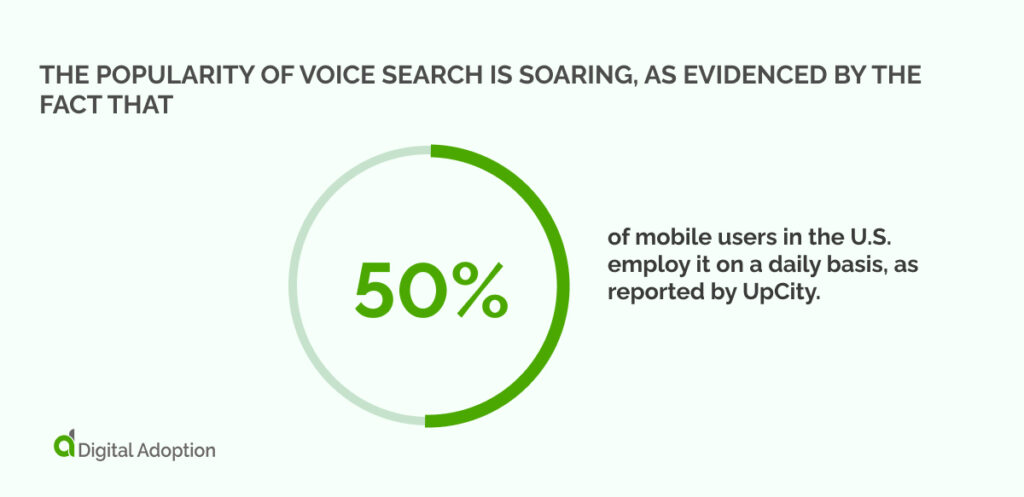
This trend highlights the increasing prevalence of AI-driven voice assistants in our daily routines. With the advancements in natural language processing and machine learning, voice assistants are becoming more intuitive and capable of understanding complex queries.
They have transformed how we interact with technology, making tasks like searching for information, setting reminders, and controlling smart devices more convenient and seamless. As this technology continues to evolve, we can expect voice search to play an even bigger role in our lives, revolutionizing the way we access and interact with digital content.
52. According to the latest research from Grand View Research, AI is projected to experience an impressive annual growth rate of 37.3% from 2023 to 2030, highlighting its potential to reshape various sectors.
This exponential expansion underscores AI technologies’ significant and escalating influence in the foreseeable future, paving the way for advancements in automation, machine learning, natural language processing, and more.
As organizations continue to harness the power of AI, we can expect to witness groundbreaking innovations and unprecedented opportunities emerge, fueling a new era of possibilities.
53. According to the report, 25% of companies are now actively embracing AI adoption to address this challenge.
By leveraging the power of AI, businesses can optimize their operations and bridge the gap caused by the lack of human resources. This strategic move not only addresses the immediate issue but also potentially enhances efficiency, productivity, and overall competitiveness in the long run. By incorporating AI technologies into their workflows, companies can unlock new opportunities for growth and innovation, propelling them ahead in the ever-evolving business landscape.
54. The same IBM report showed China is leading the way in AI adoption, with a significant 58% of companies already implementing AI into their operations.
An additional 30% of businesses in China are actively considering the integration of AI, showcasing their commitment to staying ahead in the technological landscape. In contrast, the United States has a relatively lower adoption rate, with only 25% of companies currently utilizing AI.
However, there is a promising 43% of U.S. businesses in the exploratory phase, diligently assessing the potential applications of AI to harness its benefits in the near future.
55. According to a comprehensive McKinsey report, which extensively analyzed the impact of AI-related technologies, it is estimated that between 2016 and 2030, approximately 15% of the global workforce could potentially be affected by the rapid progress in this transformative field.
As artificial intelligence (AI) continues to advance at an unprecedented rate, there is a growing concern among experts that it may lead to the displacement of a staggering 400 million workers across the globe. This highlights the need for proactive measures to mitigate the potential negative consequences and ensure a smooth transition for individuals and economies worldwide.
Chat GPT Statistics
56. User Base: ChatGPT has a robust following, with its user base reaching over 100 million. This vast number of users underscores the platform’s popularity and widespread acceptance.
57. Gender Distribution: Of these users, approximately 59.67% identify as male, while around 40.33% are female. This data provides insights into the demographic spread of the users and can inform strategies for user engagement and product development.
58. Revenue Projection: By the end of 2023, it’s estimated that ChatGPT will amass revenues of up to $200 million. This significant revenue projection reflects the platform’s growing commercial success and potential profitability.
59. Operating Costs: OpenAI, the organization behind ChatGPT, incurs daily costs of around $700,000 to run the platform. This high operational cost underscores the extensive resources required to maintain and improve such an advanced AI technology.
60. Web Traffic: The total page visits for ChatGPT have exceeded 10 billion, and it continues to receive over a billion visits each month on average. This high traffic indicates the platform’s tremendous reach and user engagement levels.
61. Traffic Source: An overwhelming majority of the traffic (over 88%) on ChatGPT is direct, with a smaller fraction (4.22%) coming from social media platforms. This data informs us about the primary sources of the platform’s user traffic and can guide marketing and user acquisition strategies.
62. Geographical Restrictions: Seven countries, including China and Russia, do not have access to ChatGPT. These restrictions indicate potential expansion areas and highlight geopolitical influences on tech accessibility.
63: Content Authenticity: Interestingly, 53% of readers were unable to distinguish between content authored by ChatGPT and human-written material. This statistic speaks volumes about the platform’s ability to generate realistic, human-like text.
64: Technological Advancements: In March 2023, OpenAI introduced support for ChatGPT Plugins and GPT-4 technology for ChatGPT Plus users, with the Canva Plugin being the latest addition. These advancements showcase the platform’s commitment to continuous development and user experience enhancement.
65: Company Valuation: OpenAI has an impressive valuation of $29 billion. This valuation reflects the company’s overall success and its significant role in the global AI industry.
What Is The Future Of Artificial Intelligence?
As we look towards the future, Artificial Intelligence (AI) is set to become an increasingly integral part of business operations, revolutionizing traditional practices and defining new ways of working.
The potential of AI in business is vast and multifaceted. From streamlining routine tasks to providing advanced analytics for strategic decision-making, AI’s influence is transformative. The digitization of existing processes automated by AI increases efficiency and frees up human resources for more complex roles. This automation extends beyond menial tasks; sophisticated AI systems can handle intricate processes like customer service, data analysis, and even content creation.
Simultaneously, AI is poised to revolutionize decision-making in businesses. Powerful AI algorithms have the capacity to analyze large volumes of data swiftly and efficiently, uncovering insights that are virtually impossible for humans to discern manually. This ability to harness big data can transform decision-making processes, enabling businesses to optimize operations, identify new opportunities, and accurately predict future trends.
The future of AI also promises to significantly enhance customer experiences. AI-powered chatbots and virtual assistants are becoming more sophisticated, offering personalized assistance to customers. Likewise, AI-driven recommendation systems are evolving to provide increasingly accurate suggestions based on individual customer preferences and behavior, further personalizing the customer journey.
However, to fully harness these benefits, businesses must proactively adapt and prepare for a future infused with AI. This preparation starts with investing in robust technological infrastructure supporting AI integration, which may involve hardware upgrades, investing in cloud services, or adopting AI-friendly software platforms.
While the future of AI in a business context is brimming with promise, it requires careful preparation and strategic investment.
Businesses proactively embracing AI, preparing for its impact, and leveraging its benefits will drive future success and stay ahead of the curve.
Sources
- https://www.pwc.com/gx/en/issues/analytics/assets/pwc-ai-analysis-sizing-the-prize-report.pdf
- https://www.mckinsey.com/capabilities/quantumblack/our-insights/the-state-of-ai-in-2023-generative-ais-breakout-year#/
- https://aiindex.stanford.edu/wp-content/uploads/2023/04/HAI_AI-Index-Report_2023.pdf
- https://www.mordorintelligence.com/industry-reports/artificial-intelligence-in-retail-market
- https://info.kpmg.us/news-perspectives/technology-innovation/thriving-in-an-ai-world/ai-adoption-retail.html
- https://finance.yahoo.com/news/artificial-intelligence-retail-market-size-122000670.html
- https://www.gartner.com/smarterwithgartner/top-10-trends-in-digital-commerce
- https://exadel.com/news/how-is-ai-used-in-retail-business/
- https://www.precedenceresearch.com/artificial-intelligence-in-manufacturing-market
- https://www.mckinsey.com/~/media/mckinsey/industries/financial%20services/our%20insights/time%20for%20insurance%20companies%20to%20face%20digital%20reality/digital-disruption-in-insurance.ashx
- https://assets.ey.com/content/dam/ey-sites/ey-com/en_gl/topics/insurance/insurance-pdfs/EY-claims-in-a-digital-era.pdf
- https://www2.deloitte.com/content/dam/Deloitte/xe/Documents/financial-services/Artificial-Intelligence-in-Insurance.pdf
- https://www.precedenceresearch.com/artificial-intelligence-in-insurance-market
- https://www.alliedmarketresearch.com/insurance-chatbot-market-A77697
- https://www.mordorintelligence.com/industry-reports/insurance-telematics-market
- https://www.pwc.com/gx/en/financial-services/fs-2025/pwc-insurance2025.pdf
- https://www.ilo.org/wcmsp5/groups/public/—dgreports/—inst/documents/publication/wcms_890761.pdf
- https://www3.weforum.org/docs/WEF_Future_of_Jobs_2023.pdf
- https://www.datarobot.com/newsroom/press/datarobots-state-of-ai-bias-report-reveals-81-of-technology-leaders-want-government-regulation-of-ai-bias/
- https://www.salesforce.com/news/stories/generative-ai-statistics/
- https://www.capgemini.com/wp-content/uploads/2019/12/AI-in-manufacturing-operations-2-1.pdf
- https://www.manufacturingleadershipcouncil.com/wp-content/uploads/2023/06/The-Future-Of-AI-In-Manufacturing-MLC-2023.pdf
- https://assets.kpmg.com/content/dam/kpmg/au/pdf/2023/trust-in-ai-global-insights-2023.pdf
- https://www.pewresearch.org/science/2023/02/22/60-of-americans-would-be-uncomfortable-with-provider-relying-on-ai-in-their-own-health-care/

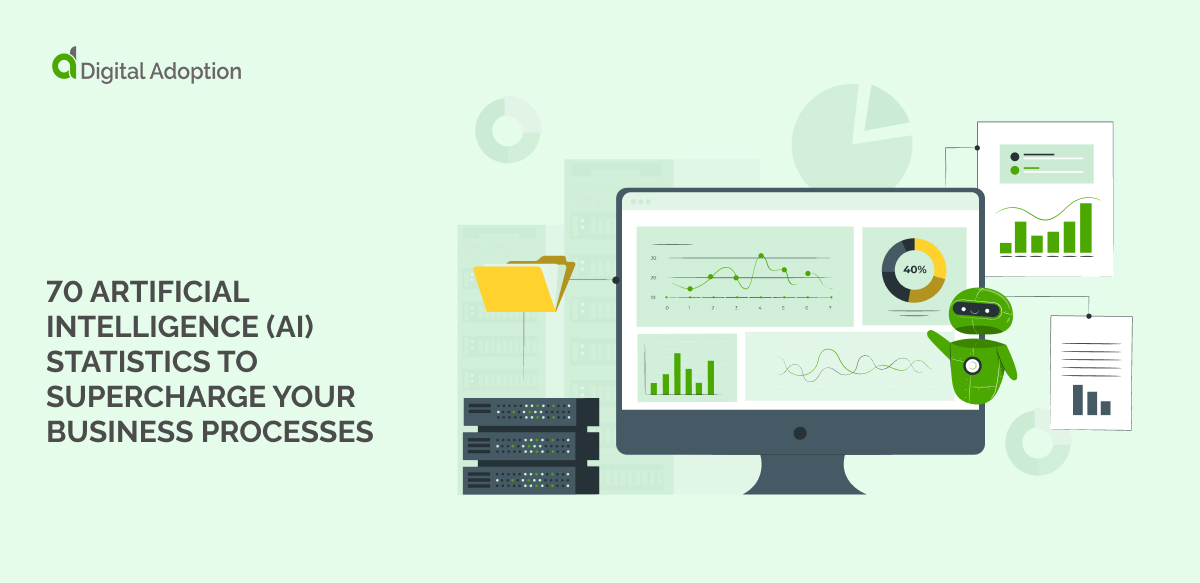


![18 Examples of AI in Finance [2025]](https://www.digital-adoption.com/wp-content/uploads/2025/06/18-Examples-of-AI-in-Finance-2025-300x146.jpg)
![14 Examples of AI in Manufacturing [2025]](https://www.digital-adoption.com/wp-content/uploads/2025/06/14-Examples-of-AI-in-Manufacturing-2025-300x146.jpg)
![29 Examples of AI in Education [2025]](https://www.digital-adoption.com/wp-content/uploads/2025/06/29-Examples-of-AI-in-Education-2025-300x146.jpg)
![15 Examples of AI in Retail [2025]](https://www.digital-adoption.com/wp-content/uploads/2025/06/15-Examples-of-AI-in-Retail-2025-300x146.jpg)
![13 Examples of AI in Healthcare [2025]](https://www.digital-adoption.com/wp-content/uploads/2025/06/AI-in-healthcare-examples-300x146.jpg)


![18 Examples of AI in Finance [2025]](https://www.digital-adoption.com/wp-content/uploads/2025/06/18-Examples-of-AI-in-Finance-2025.jpg)
![14 Examples of AI in Manufacturing [2025]](https://www.digital-adoption.com/wp-content/uploads/2025/06/14-Examples-of-AI-in-Manufacturing-2025.jpg)
![29 Examples of AI in Education [2025]](https://www.digital-adoption.com/wp-content/uploads/2025/06/29-Examples-of-AI-in-Education-2025.jpg)